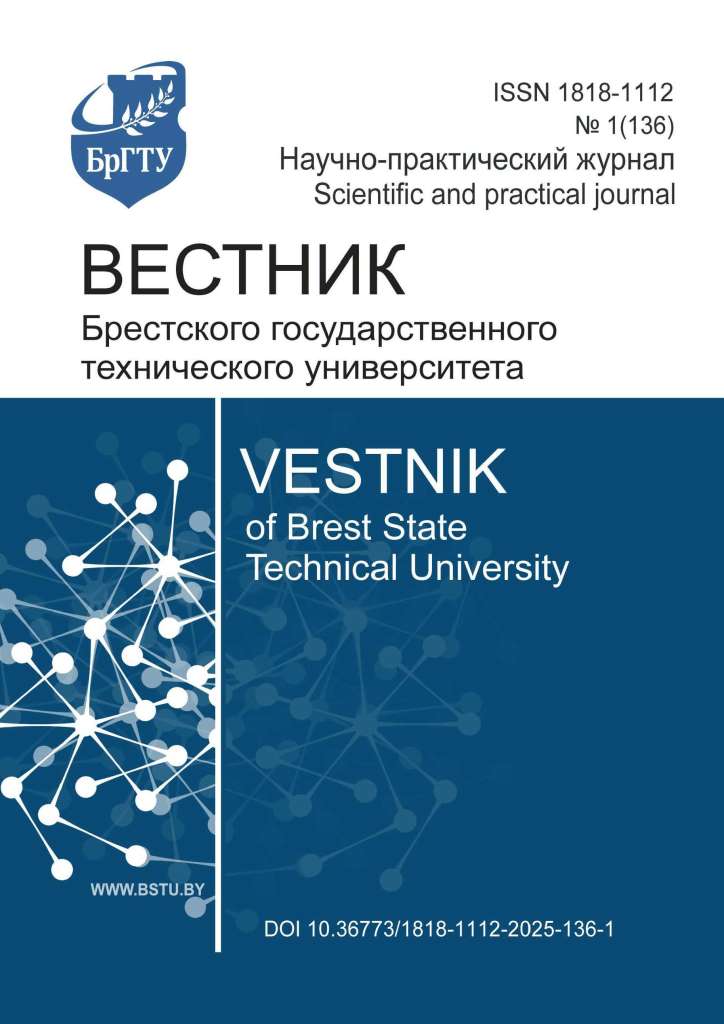ECONOMIC WATER IRON REMOVAL STATION USING THE TECHNOLOGY: «DRY FILTRATION»
DOI:
https://doi.org/10.36773/1818-1112-2025-136-1-143-148Keywords:
water iron removal, filtration, water-air ratio, iron removal station, dry filtrationAbstract
Currently, the most common methods of iron removal from groundwater are simplified and deep aeration. After aeration, hydrolysis and oxidation, iron (III) hydroxide is formed, which is retained on filters with granular loading. They are periodically washed. As a result, significant volumes of wash water heavily contaminated with iron compounds are formed. The methods of treating wash water recommended by the building codes of the Republic of Belarus SN 4.01.01-2019, BY. Water supply. External networks and structures [2] are ineffective, their discharge after settling to the head of the structures significantly reduces the filtration cycle and worsens the quality of the filtrate. As a result, operating organizations refuse to reuse wash water and discharge it into watercourses. This problem can be solved in two ways:
- Development of new highly efficient technologies for treating wash water.
- Implementation of iron removal technologies, during the implementation of which a minimum volume of wash water is formed.
One of the promising methods of iron removal is the "dry filtration" method. Its advantage is the absence or minimum volumes of wash water, since the duration of the filtration cycle is from several months to a year. Physicochemical, technological, mathematical methods were used.
As a result of the experiment, which lasted continuously for 18 months, high efficiency of iron removal of groundwater of the Alb-Cenomanian aquifer by the "dry filtration" method was established. With a filter bed made of foamed polystyrene with the parameters: d50 = 1.6 mm, heterogeneity coefficient Kn. = d80 / d10 = 2.75 and equivalent diameter decv. = 2.8 mm, filtration speed of 8 m / h, a stable effect of iron removal of water was achieved. At a water-air ratio of 1:3, the residual iron content was no more than 0.2 mg/l, and the filtration cycle duration was 20 days. Based on the results obtained in production conditions, a new design of an underground water iron removal station is proposed, which implements the "dry filtration" method, protected by a patent for a utility model.
The area of the iron removal station is reduced due to the compact arrangement of the structures. The filtration cycle is increased to 8...12 months, due to the fact that the air outlet pipe is located at the bottom of the dry filters, which creates conditions for the formation of a dense dehydrated film of iron compounds and leads to a small increase in pressure losses during operation of dry filters, and, consequently, to an increase in the filtration cycle. There is no backwash water, since the load in the dry filter is completely replaced after the end of the filtration cycle. Operation of the station is simplified, since no need for filter backwashing and backwash water treatment.
References
О Государственной программе «Комфортное жилье и благоприятная среда» на 2021–2025 годы : постановление Совета Министров Республики Беларусь от 28 января 2021 г. № 50 // Национальный правовой Интернет-портал Республики Беларусь. – URL: https://pravo.by/document/?guid=12551&p0=C22100050 (дата обращения: 23.01.2025).
Водоснабжение. Наружные сети и сооружения: строительные нормы Республики Беларусь : СН 4.01.01-2019, BY. – Взамен ТКП 45-4.01-320-2018 (33020) ; введ. 09.07.2020. – Минск : Минстройархитектуры, 2020. – IV, 68 с.
Станкявичюс, В. И. Обезжелезивание воды фильтрованием (основы теории и расчет установок) / В. И. Станкявичюс. – Вильнюс : Мокслас, 1978. – 120 с.
Технические записки по проблемам воды: в 2-х т. / К. Бараке, Ж. Бебен, Ж. Бернар [и др.] ; под ред. Т. А. Карюхиной, И. Н. Чурбановой. – М. : Стройиздат, 1983. – 609 с.
Рапопорт, Я. Д. Применение водовоздушной промывки при обезжелезивании воды фильтрованием / Я. Д. Рапопорт, Ю. И. Татанов // Водоснабжение и санитарная техника. – № 8. –1997. – С. 20–21.
Любарский, В. М. Осадки природных вод и методы их обработки / В. М. Любарский – М. : Стройиздат, 1980. – 128 с.
Мякишев, В. А. Сокращение потерь воды на сооружениях очистки поверхностных вод / В. А. Мякишев, Л. Д. Субботкин // Водоснабжение и санитарная техника. – № 8. – 2002. – С. 12–14.
Новиков, М. Г. Утилизация промывных вод фильтровальных сооружений на водоочистных станциях / М. Г. Новиков, Н. Г. Иванова, Л. П. Дмитриева // Вода и экология. – № 1. – 2000.
Румянцева, Л. П. Брызгальные установки для обезжелезивания воды / Л. П. Румянцева – М. : Стройиздат, 1973. – 104 с.
Шевченко, Л. Я. Утилизация осадков водопроводных станций / Л. Я. Шевченко // Водоснабжение и санитарная техника. – № 4. – 1985. – С. 21.
Белескова, Е. А. Об утилизации осадков, образующихся при обезжелезивании подземных вод / Е. А. Белескова, В. И. Айзенберг // Водные ресурсы. – 1979. – № 5. – С. 190.
Алферова, Л. И. Повторное использование промывных вод и утилизация осадка на станциях очистки подземных вод / Л. И. Алферова, Е. И. Курочкин, В. В. Дзюбо // Водоочистка. – № 6. – 2008. – С. 26–31.
Сукасян, Б. Д. Исследование процесса обезжелезивания подземных вод методом водовоздушного фильтрования: автореф. дис. … канд. техн. наук : 05.23.04 / Б. Д. Сукасян ; инж. стороит. инст. им. В. В. Куйбышева – М., 1979. – 20 с.
Золотова, Е. Ф. Очистка воды от железа, марганца, фтора и сероводорода. / Е. Ф. Золотова, Г. Ю. Асс. – М. : Стройиздат, 1975. – 176 с.
Кульский, Л. А. Технология очистки природных вод / Л. А. Кульский, П. П. Строкач. – Киев : Вища школа, 1986. – 352 с.
Николадзе, Г. И. Обезжелезивание природных и оборотных вод / Г. И. Николадзе. – М. : Стройиздат, 1978. – 161 с.
Старинский, В. П. Водозаборные и очистные сооружения коммунальных водопроводов : учебное пособие для студентов вузов, обучающихся по специальности 2908 "Водоснабжение, канализация, рациональное использование и охрана водных ресурсов" и 29.05 "Коммунальное строительство и хозяйство" / В. П. Старинский, Л. Г. Михайлик. – Минск : Вышэйшая школа, 1989. – 269 с.
Житенев, Б. Н. Повышение эффективности обезжелезивания подземных вод альб-сеноманского водоносного горизонта «сухой фильтрацией» / Б. Н. Житенев, Г. О. Наумчик // Вестник Брестского государственного технического университета. Серия: Водохозяйственное строительство и теплоэнергетика. – 2007. – № 2 (44). – С. 77–81.
Станкевич, Р. А. Артезианские воды Бреста и их использование: Природные условия, история освоения и пути прогресса / Р. А. Станкевич. – Мн. : Адукацыя i выхаванне, 2004. – 184 с.
Санитарные правила и нормы СанПиН 10-124 РБ 99. Питьевая вода. Гигиенические требования к качеству воды централизованных систем питьевого водоснабжения. Контроль качества // Сборник санитарных правил и норм по питьевому водоснабжению / Министерство здравоохранения Республики Беларусь. – Минск, 2000. – С. 3–108. – Введ. 19.10.99.
Патент 2461 BY, МПК C 02F 3/10. Станция обезжелезивания : № u20050191 : заявлено 05.04.2005 : опубл. 17.10.2005 / Житенев Б. Н., Гуринович А. Д., Наумчик Г. О. ; заявитель Брестский гос. техн. ун-т // Гос. реестр полезн. моделей.
Downloads
Published
How to Cite
Issue
Section
License

This work is licensed under a Creative Commons Attribution-NonCommercial 4.0 International License.
The work is provided under the terms of Creative Commons public license Attribution-NonCommercial 4.0 International (CC BY-NC 4.0). This license allows an unlimited number of persons to reproduce and share the Licensed Material in all media and formats. Any use of the Licensed Material shall contain an identification of its Creator(s) and must be for non-commercial purposes only. Users may not prevent other individuals from taking any actions allowed by the license.










